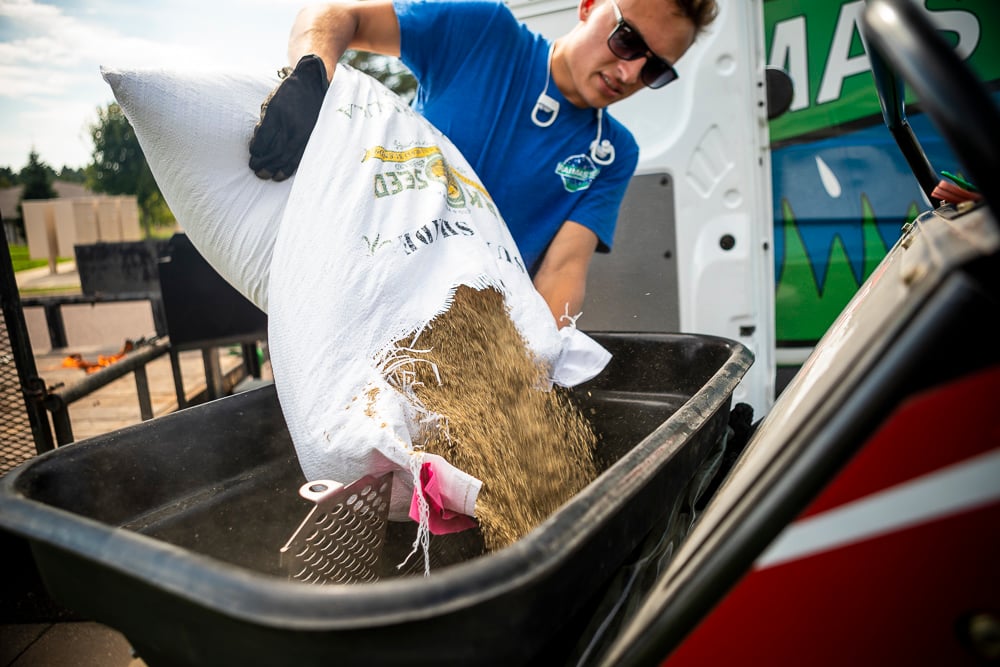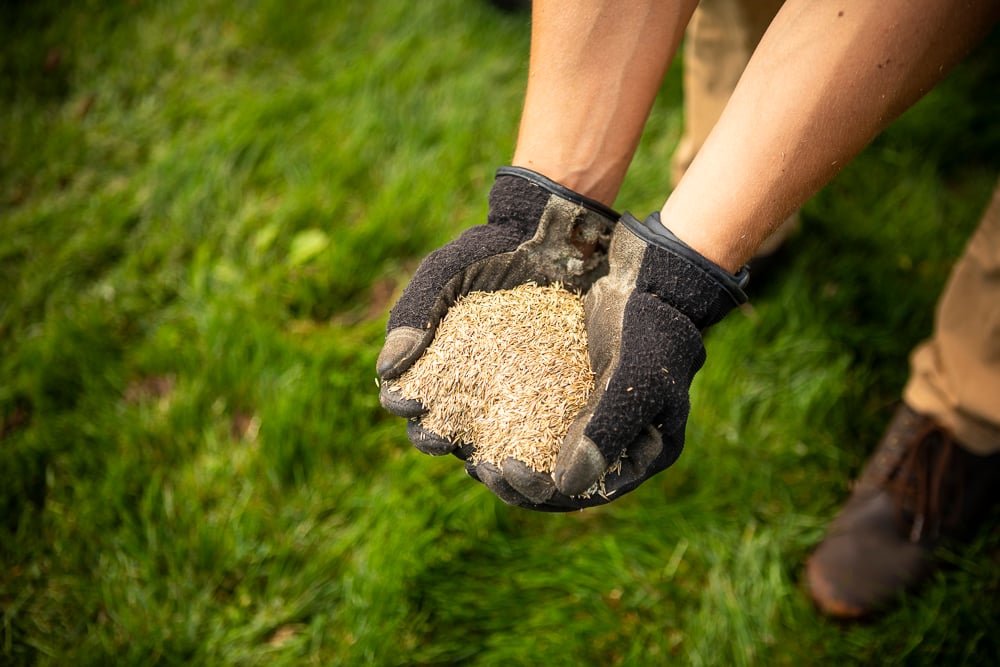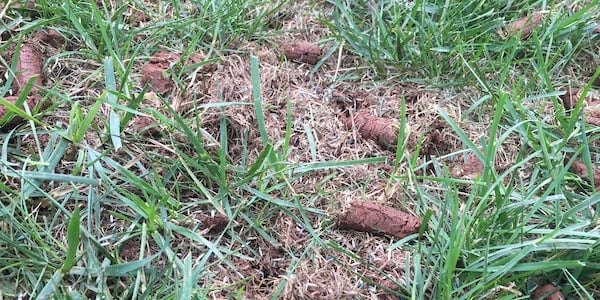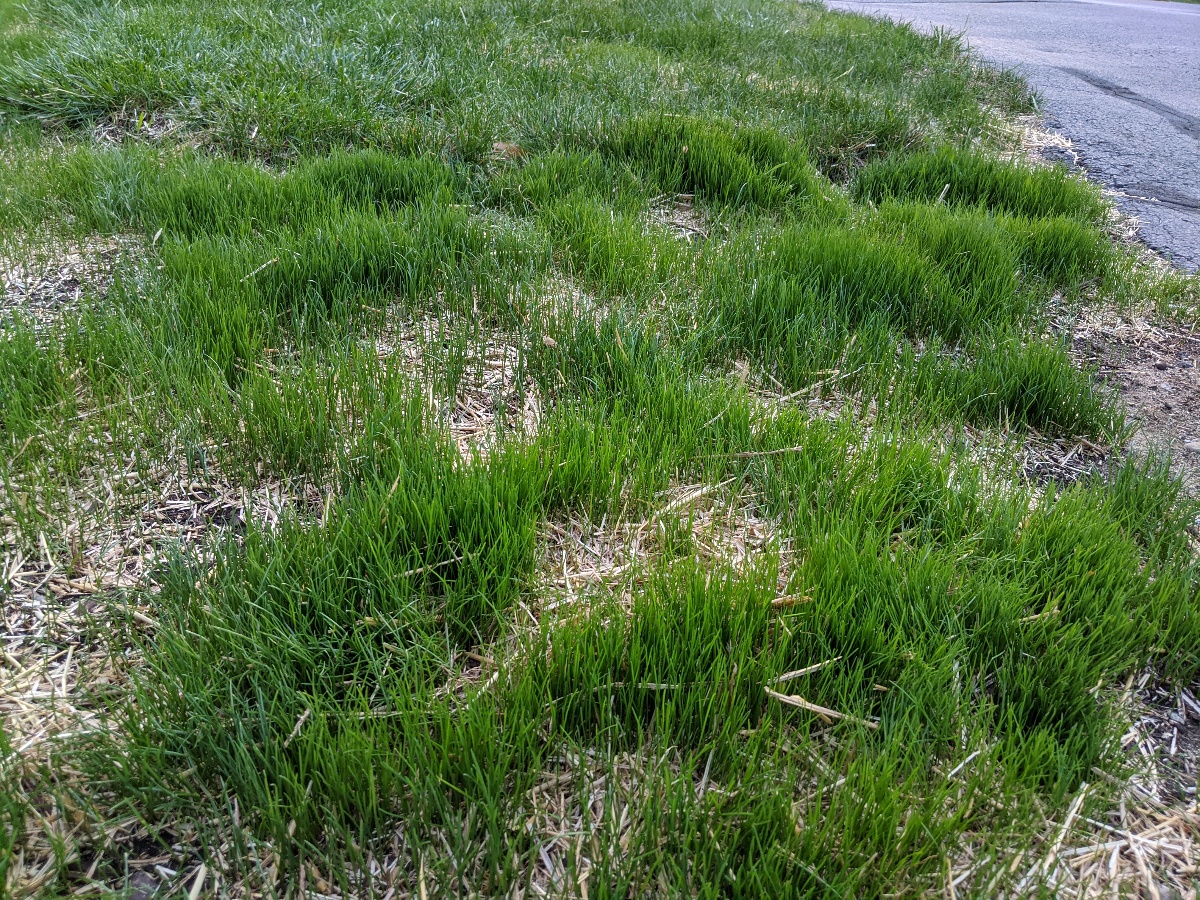A quick quiz: Which one of these things will happen on its own, with no help from you:
A. Your kids will clean their rooms
B. Dinner will appear on the table (fast food bags don’t count.)
C. Grass will spread to fill in your lawn’s bare spots
Answer: Sorry, none of the above. Life can be cruel.
Technically, Kentucky bluegrass, which is common in grass seed blends used in Wisconsin and Minnesota, can spread on its own. But it can take years. Much like waiting for your kids to clean their rooms.
So what’s your best plan for filling in lawn bare spots?
Here’s a look.
Does Grass Spread on Its Own?
It depends on the type of grass.
Kentucky bluegrass has runners that help it spread on its own.
But many northern grasses are bunch-type grasses which don’t spread, so seeding is needed to fill in bare spots. Perennial ryegrass and fescue are among the non-spreaders.
Most grass seed used here in Wisconsin and Minnesota is a blend of Kentucky bluegrass, rye and fescue.
-1.jpg?width=1200&name=bare%20spots%20in%20lawn%201%20(1)-1.jpg) Kentucky Bluegrass actually does spread on its own. You might even see it creeping into your rock garden or starting to cover your irrigation system valve box.
Kentucky Bluegrass actually does spread on its own. You might even see it creeping into your rock garden or starting to cover your irrigation system valve box.
The thing is, it’s not in a hurry. You, on the other hand, probably are in a hurry to fill in your lawn’s unsightly bare spots. Especially if those spots involve ugly lawn disease, dog urine spots, or a lawn mower gas or oil spill.
And you know what does spread on its own, with frustrating speed? Weeds! They love filling in lawn bare spots.
So why wait?
Follow these tips for filling in lawn bare spots:
1. Be Sure the Environment is Right
If you’re trying to fill in lawn bare spots in the shade, you can spread grass seed all you want and still be waiting for grass to fill in.
Most turf grasses need at least four hours of direct sun to survive.
You might have to thin your trees or branches to let more sunlight through to your turf before seeding those bare spots.
2. Plant Seed at the Right Time of Year
Fall is the best time to plant seed to fill in lawn bare spots. The season brings a great mix of warm soil, cool air, rainy days, and time for new grass roots to develop before winter sets in.
Also, there aren’t as many weed seeds blowing around in the air in the fall, looking for a cozy place to settle in.
 But don’t plant grass seed to fill in bare spots too late in the season— or too early. You don’t want your baby seedlings zapped by frost or freezing temperatures.
But don’t plant grass seed to fill in bare spots too late in the season— or too early. You don’t want your baby seedlings zapped by frost or freezing temperatures.
Shoot for mid-May through late September.
3. Don’t Let Pre-emergent Spoil the Fun
We’re not going to ruin your good mood by saying crabgrass (oops, too late) but if you’re using pre-emergent to prevent it, hold off on planting grass seed to fill in lawn bare spots.
That great pre-emergent that prevents crabgrass also prevents grass seed from germinating. So you can’t seed and prevent crabgrass at the same time.
There is some good news here: If you live near Eau Claire, WI or the Minneapolis area you can partner with RainMaster to do your lawn care, and get a pro-level product that will kill weeds without harming your new grass.
4. Choose the Right Seed to Fill in Bare Spots
This is a big one.
Skip the cheap seed, please. First off, that inexpensive grass seed piled up in bags in the home improvement store may actually contain weed seeds and undesirable grass seed.
Also, be sure the seed you’re planting to fill in lawn bare spots is the same variety as the rest of your lawn.
 If you have dark green grass and buy the wrong type of seed, you might fill in those bare spots with bright green grass that doesn’t match. Do you really want to give the neighbors another thing to whisper about?
If you have dark green grass and buy the wrong type of seed, you might fill in those bare spots with bright green grass that doesn’t match. Do you really want to give the neighbors another thing to whisper about?
Pay the extra to get high quality grass seed that will blend with your lawn.
5. Be Sure the Seed Has Soil Contact
You can’t just stroll around your yard scattering grass seed like a wedding flower girl tossing rose petals.
Scratch the seed in, please, to make sure it snuggles right in with the soil so it can germinate. (More seeding tips in a minute.)
6. Limit Foot Traffic as Your Seed Sprouts
Give that tender baby grass a chance to take hold and fill in lawn bare spots. No backyard soccer games, marching band practice, or limbo contests with the neighbors.
7. Consider Aeration to Help Fill in Lawn Bare Spots
If bare spots are a continuing problem, your soil might be compacted. If that’s the case, seed alone won’t fix the problem.
When your soil becomes compacted, your lawn can't breathe. Its roots can't take in water or nutrients, which weakens your turf and opens the door for disease and weeds.
 Lawn aeration uses a machine to pull out plugs of soil, creating spaces so that air and water can penetrate, which leads to healthier roots.
Lawn aeration uses a machine to pull out plugs of soil, creating spaces so that air and water can penetrate, which leads to healthier roots.
After aeration, seed away! Those holes created by aeration are perfect new homes for the grass seed.
New to This Whole Planting Grass Thing?
Follow these steps:
Rake out any dead, matted turf. Your grass seed will germinate and root best if It can snuggle up to bare soil.
Dig and loosen the soil a bit to prepare it for the seed.
 Scatter grass seed over the loosened soil. Scratch it in a bit and tamp it down so you know there’s good contact.
Scatter grass seed over the loosened soil. Scratch it in a bit and tamp it down so you know there’s good contact.
Add some fertilizer designed for new grass to get it off to a good start.
Keep it watered. When your grass is new, it needs more frequent light watering in smaller amounts. This usually means watering your lawn two or three times a day for 15-20 minutes.
Filling in Bare Spots in Your Lawn? Trust it to RainMaster
Filling in lawn bare spots is just the beginning. Your lawn needs you to be in this for the long haul.
Invest in a complete, proactive lawn care program to continuously improve and protect your lawn.
Consider it a team effort. Let’s create a custom nutrition plan for your Eau Claire, WI or Minneapolis area lawn, so the roots will be nourished, the soil packed with nutrients, and your grass thick and healthy, so it resists the troublemakers that cause bare spots in your lawn.
Choose from three different levels of lawn care programs, based on the results you’d like, how fast you want to see results, and your budget.
Spare yourself the drama of lawn bare spots and get to the bottom of your lawn problems. Request a quote today! We’ll review your lawn care options together so you can make a great choice. Then, you can finally enjoy your lawn and stop worrying about it.



